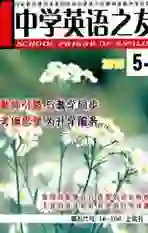一般过去时大盘点
2010-07-14姜经志
姜经志
①Many years ago, there was a doctor in a small town. He was good and kind. At any time of the day and night, he was always ready to go and help the sick people. ②Everyone in the town liked him and people always went to see him when there was something wrong with them.
After many years the doctor became old. He began to lose his memory(记忆力), so he often forgot things. ③When people noticed(注意到) this, they did not go to see him any more.
④“He may give us the wrong medicine,” they said, and they were afraid(害怕) of that. But he did not understand why. So he asked why no one came to see him then. No one wanted to tell him the real reason(原因) because they did not want to make the old man unhappy.
①Many years ago, there was a doctor in a small town.
[解析]此句为be动词的一般过去时。该句意为:许多年前,在一座小城镇里有一位医生。
[归纳]当我们想要表示在过去某一时间发生的动作或存在的状态时,应用一般过去时。
be 动词的一般过去式的两种形式是was与were。was是am, is的过去式;were是are的过去式,所以be动词的一般过去时有人称和数的变化。
肯定句:主语+was/were+表语+其它成分。
否定句:主语+was/were+not+表语+其它成分。
一般疑问句:Was/Were+主语+表语+其它成分?
肯定回答:Yes, 主语+was/were.
否定回答:No, 主语+wasnt/werent.例如:
I was late yesterday morning. 昨天上午我迟到了。
Li Ming and Li Mei were not here this morning. 今天上午李明和李梅不在这儿。
——Were you at school yesterday? 昨天你在学校吗?
——Yes, I was./No, I wasnt. 是的,我在。/不,我不在。
——Were they all here half an hour ago? 半小时前他们都在这里吗?
——Yes, they were./No, they werent. 是的,他们在。/不,他们不在。
[拓展与延伸]一般过去时的时间状语有哪些?
一般过去时有着明确的表示过去的时间状语,只要认准了它,就可以判定谓语动词应用过去式。一般过去时常见的时间状语有:
(1)句中有表示明确的过去时间yesterday 或yesterday morning/afternoon/evening 等。例如:
——Was he there yesterday? 昨天他在那儿吗?
——Yes, he was./No, he wasnt. 是的,他在。/不,他不在。
(2)由“时间段+ago”构成的短语,如:a moment ago(刚才), half an hour ago(半小时前), three days ago(三天前)等。例如:
He went to school ten minutes ago. 十分钟前他去上学了。
(3)由“last+时间状语”构成的过去时间短语,如:last night/week/month/year/spring等。例如:
Was she at work last night? 昨晚她在上班吗?
(4)由before构成的介词短语,或句中出现一些表示过去时间的固定词语,如:the day before yesterday(前天), just now(刚才), once(从前)等。例如:
Where were you the day before yesterday? 前天你在哪里?
(5)句子中有“介词+表示过去的年月日”,如:in 2005; on May 15, 2009等。例如:
I was born in 1995. 我出生于1995年。
(6)没有明显的时间状语,但句子表示过去经常或反复发生的动作,此时也有often, always 等频度副词表示的时间状语。例如:
He was often late for school last term. 上学期他经常上学迟到。
②Everyone in the town liked him and people always went to see him when there was something wrong with them.
[解析]此句为实义动词的一般过去时,liked为动词like的过去式。该句意为:小镇上的人都喜欢他,当他们生病时,总是到他那儿去看病。
[归纳]实义动词的过去式,其变化分为规则和不规则两种。
规则动词过去式的构成:
1. 一般在动词原形末尾加-ed。如:look→looked, watch→watched等;
2. 以e结尾的动词末尾只加-d, 如:like→liked, hope→hoped等;
3. 末尾只有一个辅音字母的重读闭音节的动词,先双写该辅音字母,再加-ed。如:plan(计划)→planned, stop→stopped等;
4. 结尾是“辅音字母+y”的动词,先将“y”变为“i”,再加-ed。如:carry→carried, worry→worried, study→studied等。
[特别提醒]结尾是“元音字母+y”的动词,变为过去式时直接在词尾加-ed。如:play→played, stay→stayed等。
[拓展与延伸]一般过去时主要有以下几种用法:
1. 表示在过去某个时间里发生的动作或存在的状态。例如:
Lin Tao went to school at 7:00 this morning. 林涛今天早上七点去上学。
Her mother was ill last night. 昨晚她母亲生病了。
2. 表示过去经常或反复发生的动作。例如:
Liu Fang always went to school by bus last term. 上学期刘芳一直乘公共汽车上学。
3. 表示已故的人所做的事情。例如:
Lei Feng did good deeds in his life. 雷锋做了一生的好事。
Lu Xun wrote many great works. 鲁迅生前写过许多不朽的作品。
4. 表示过去所发生的一系列的动作。例如:
He came into the room, turned on the light and sat down at the table.
他走进屋,打开灯,然后坐在桌旁。
Mr Brown got up at six oclock this morning, dressed, had breakfast, and went to work by bike. 布朗先生今天早上六点起床、穿衣服、吃饭,然后骑自行车去上班了。
③When people noticed this, they did not go to see him any more.
[解析]该句为实义动词的一般过去时的否定形式。句意为:当人们注意到这一点,他们不再去他那儿看病了。
[归纳]实义动词在一般过去时的各种句式(包括各种答语)中的用法同一般现在时,但没有人称和数的变化,即:do/does→did。请看:
She worked in the office last year. (改为一般疑问句,并作肯定和否定回答)
→——Did she work in an office last year?
——Yes, she did./No, she didnt.
I watched TV last night. (改为否定句)
→I didnt watch TV last night.
[拓展与延伸]在肯定句中,谓语动词要用过去式(实义动词的过去式没有人称和数的变化);但是改为否定句时,要把谓语动词改为“didnt+动词原形”;改为一般疑问句时在句首加助动词did, 句中的动词也要改为原形;改为特殊疑问句时,将疑问词放在句首,句中要使用助动词,句中的动词要使用原形,但当疑问词作主语时,则无须使用did, 句中的动词仍使用其过去式。例如:
They played football yesterday afternoon. (肯定句)
→They didnt play football yesterday afternoon. (否定句)
→Did they play football yesterday afternoon? (一般疑问句)
→When did they play football? (特殊疑问句)
→Who played football yesterday afternoon? (特殊疑问句)
④“He may give us the wrong medicine,” they said…
[解析]said是动词say的过去式,它是一个不规则变化。该句意为:“他可能会给我们拿错药,”他们说。
[归纳]动词过去式不规则变化常见的有以下几点:
1. 原形和过去式相同的有:let, put, read 等。
2. 过去式含aught或ought的动词共有5个,是aught还是ought, 请看动词原形。若原形中第一个元音是a, e, 这个单词的过去式则是aught; 若第一个元音字母是i或u,这个单词的过去式则是ought。例如:
catch→caught, teach→taught, buy→bought, bring→brought, think→thought
3. 过去式含ould 的单词共有3个,can, will, 从第一个元音字母开始变化。例如:
can→could, will→would, shall→should
4. 原形含ow或aw的动词,则变为ew。例如:
know→knew, grow→grew, throw→threw, draw→drew, 特例show→showed
5. 含ee, eep或eel的动词,则变成ept或elt, 或去掉一个e即成过去式。例如:
feel→felt, sleep→slept, keep→kept, sweep→swept, meet→met
6. <1>含i或a的动词,在开音节中,过去式变i 或a为o即成。 例如:
write→wrote, drive→drove, ride→rode, wake→woke
<2>含i 或u的动词,在闭音节中,过去式常把i 或u变成a即成。例如:
sit→sat, swim→swam, drink→drank, ring→rang, sink(下沉)→sank, run→ran, give→gave特例win(获胜)→won
7. 以d结尾的部分动词,过去式则是把d变成t即成。例如:
build→built, lend→lent, spend→spent
8. 原形含ay的动词,则变为aid。例如:
say→said, pay→paid
